After two decades of violent conflict in the city of Mosul, Iraq, Dr Omar Mohammed, founder of the Mosul Eye organisation, started a tree-planting initiative to help bring communities together. In the United States, Dr Marc Zimmerman examined how greening and improvement initiatives reduced crime in cities that had suffered economic decline.
In this episode, Dr Omar Mohammed and Dr Marc Zimmerman, interviewed by Dr Nafees Hamid, discuss the role of greening initiatives in these two different contexts, exploring how they can promote peace, build trust between communities and authorities, and help to increase resilience against violent crime and extremism.
You can also listen on the War Studies podcast page, where this was originally released.
Beirut is the posterchild for a divided city.[i] 15 years of fighting during Lebanon’s civil war (1975-1990) saw the capital city split by ethnic, religious, and physical lines. These divisions did not end with the war. Over three decades later, sectarianism, segregation, economic inequality, and violence are a lasting part of Beirut’s post-war legacy.
The physical reconstruction of the city centre in post-war Beirut is believed to have played a role in these enduring divisions. When the reconstruction process began, many Beirutis saw it as an opportunity for society to heal. The public domain could be remade and revived, and in this way a space for reconciliation would be built.
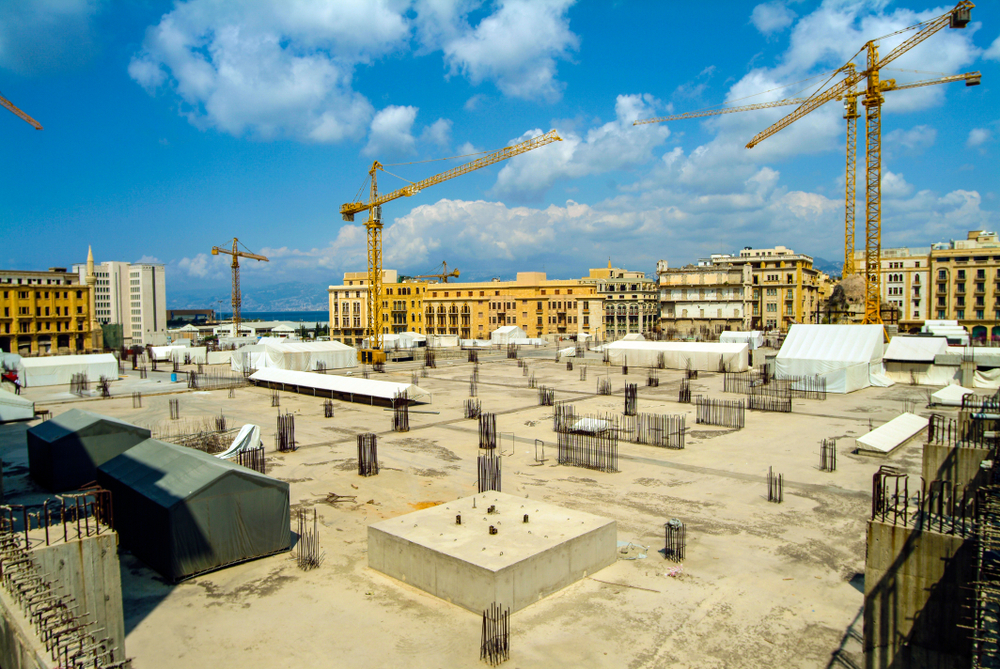
Solidere building site in Beirut. Credit: Shutterstock/David Dennis
Instead, the work, which was carried out by the private company Solidere, has been accused of promoting a culture of ‘amnesia’ around the civil war, as well as exacerbating socio-economic divisions. When Solidere rebuilt Downtown Beirut, they sought to remove all physical remnants of the war. In their place, a shiny new imagined centre was built.
But burying traces of war does not necessarily mean the past is buried too – and failing to create a unified space may be contributing to a divided society.
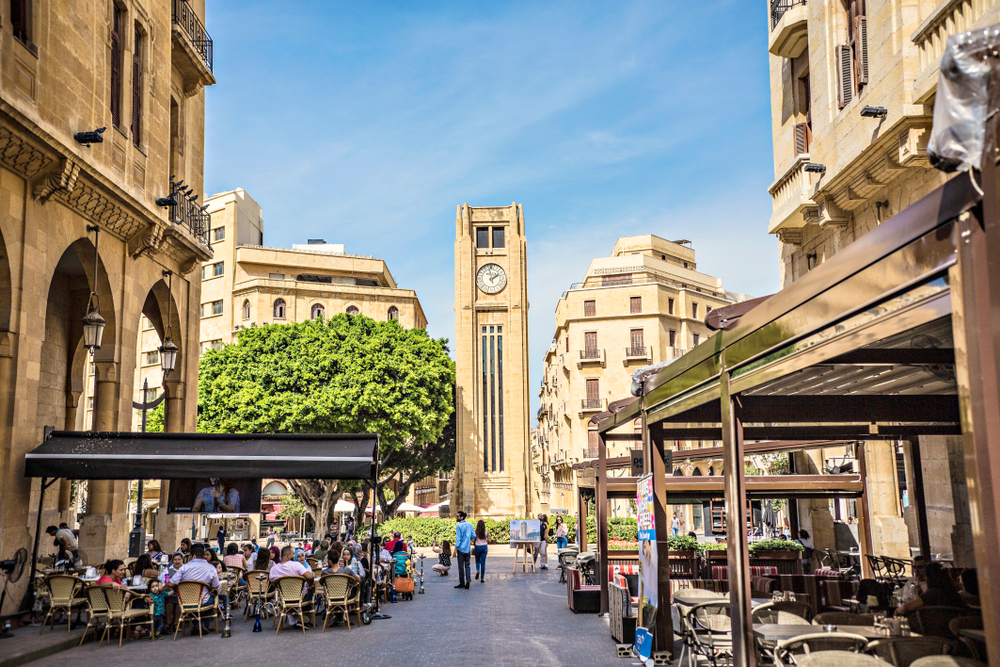
Nejmeh Square in Downtown Beirut. Credit: Shutterstock/Sun_Shine
Solidere’s reconstruction process, which began shortly after the war ended, seemed set on destroying all traces of recent history, and streets and buildings quickly fell prey to the bulldozers. By 1993, 80 per cent of structures in Downtown were damaged irreparably – yet only a third of this had been caused by the war itself.[ii]
For many, Solidere’s reconstruction of Downtown is the embodiment of the state’s policy of amnesia. The Taif Accord signed in 1989 to formally end the civil war proclaimed that there was ‘no victor and no vanquished’ in Lebanon. It suggested no mechanism for dealing with the legacy of fighting, nor did it mention victims. By circumventing the issue of responsibility, the state could begin to move forward. At the same time, it encouraged a culture of forgetting, leading to accusations of a state-sponsored amnesia in the country. One activist noted that ‘the downtown is the core of the reconstruction ideology — that we don’t need to look at the past’.[iii]
It’s been claimed that, for ‘communities of difference’ to be successful, there must be a ‘studied historical absentmindedness’.[iv] Given a general amnesty law in 1991, a broadcasting censorship law in 1994, and a law in 1995 enabling ‘the missing’ to be classified as ‘dead’, it seems unlikely that remembering the past would yield justice in the present. This ‘amnesia’ could therefore help to promote harmonious co-existence.[v] For some, forgetfulness is seen as ‘an antidote to future conflict’.[vi]
Read the full blog on the ICSR website here.
South Sudan is highly susceptible to both protracted conflicts and the impacts of climate change. Before 2011, the country experienced a long and deadly civil war. Disputes continued after independence, with violence often spilling over across borders and into nearby countries. Local impacts of climate change (e.g., droughts, flooding) disrupt economic growth and community livelihoods, potentially contributing to conflict and destabilising the region. Climate adaptation and food security can therefore have important implications for reducing violence, particularly social conflicts that involve local ethnic militias, civil defence forces, and vigilantes.
To test these implications, I collected monthly information on climate adaptation and food security projects implemented by nongovernmental organisations in South Sudan and its bordering countries between January 2012 and December 2022. Such measures include, among others, planting more resilient crops, building dams and granaries, managing environmental resources such as grazing land or water reservoirs, and training locals in more effective sustainable food production.
Unfortunately, I did not find that these types of adaptation projects have any impact on social conflict or civil war. In fact, at least in South Sudan, there was the risk that they might be associated with more conflict. A project manager I interviewed provided one explanation: “South Sudan is a complex crisis country …[while] flooding and drought have led to displacements, people move into new geographies, and conflict scenarios shift.” In these complex situations, adaptation can exacerbate these dynamics, especially if the root cause is political or socioeconomic; or, as another local policy ethnographer explained, “you cannot just ask for a local solution and detach national politics from the local issues.”
However, I did find one interesting exception. Adaptation interventions that emphasised general preparedness – including, for example, efforts to plant more resilient crops, train locals in more effective sustainable food production, and create sharing tools for renewable resources like water – were associated with lower rates of social conflict, both within South Sudan and across the border.
Why might adaptation that emphasises general preparedness help in alleviating violence? One explanation builds on the nature of social conflict actors. Social conflict actors are more prevalent than military, police, or rebel groups in the region because they thrive in contexts of weakened or decentralised government. Because these actors are more dependent on locally-sourced crops and cattle, they may also be more sensitive to the effect of weather shocks upon these resources. Adaptation strategies that emphasise general preparedness can address – albeit imperfectly – a wider range of unexpected weather shocks, reducing the need for violent competition over scarce resources.
Another explanation emphasises the disruptions the civil war caused to local livelihoods. As one policy researcher explained, by emphasising specialised adaptation, “programming tends to incentivize specific livelihood strategies…which do not respond to local livelihood trajectories.” This can increase uncertainty about the future, considering climate change’s effects are hard to predict. In contrast, adaptation strategies that emphasise building general resilience can provide local communities with more flexibility, allowing them to choose whether to maintain traditional livelihoods or, if needed, adapt to new ones.
Regardless of which explanation is correct, the finding that adaptation programs that emphasise general preparedness may help reduce conflict illustrates how important it is to consider a broad set of direct and indirect outcomes when trying to tailor climate adaptations to conflict contexts.
Nevertheless, it can be hard to convince donors who fund adaptation that this approach makes sense. Donors have their own expectations when choosing which project to fund, which leads to “top-down” pressures that often do not conform well to the local realities, where social conflict poses a constant hardship. The problem is that, “[m]ost donors don’t understand the complexities…it’s really difficult to be able on the one hand to put a proposal that supports donor demand but on the other hand, is really context driven,” as one policy practitioner explained.
At the same time, it is imperative to convince donors that considering a wider range of outcomes will improve the chances of success. Understanding how interventions designed to support climate adaptation and promote food security can be tailored to local conditions in conflict settings is crucial. By investing in projects that have a better chance not only of improving adaptation in the immediate terms, but also of reducing the risk of violence, we can improve long term resilience, thereby preventing conflict from disrupting livelihoods and harming adaptation efforts.
Dr Omar Mohammed is a renowned historian and the voice behind ‘Mosul Eye’, a blog which anonymously documented life under Islamic State (IS) in the city of Mosul, Iraq. Today, the Mosul Eye Association focuses on promoting the recovery of Mosul and its cultural heritage, as well as empowering the city’s youth. The most important task Mosul Eye is undertaking is to promote Mosul globally to replace the negative image of the city after its fall to IS in 2014 and the subsequent destruction.
Hi Omar. Thanks for joining us. Please could you explain what Green Mosul is?
Green Mosul was an initiative started by Mosul Eye, and ultimately led by youth, to plant trees in the city of Mosul, but really it has two definitions. It refers to the greening initiative, which was the effort to repopulate Mosul with green space after the massive estruction that took place during the conflict. But it really aimed at, and can be defined as, an initiative to support reconciliation in post-war Mosul.
Following the conflict, there was a need to bring the people together, and to do that we needed to find something everyone could relate to. We wanted to disconnect them for a short time from the religious and social problems in the city, and we settled on one thing they could agree on: a tree. A tree doesn’t have a religion. It doesn’t have an ethnicity. It only has what benefits the community: clear, clean oxygen, a good view, and the ability to create a nice landscape.
Green Mosul ran from March 2022 to March 2023, and, in that time, we planted 9,000 trees in Mosul and the wider Nineveh province. When we started the initiative, we signed agreements with the local government and with the universities, and one of the terms was that they would commit to planting trees every year. Green Mosul has now technically ended, but the University of Mosul and the Technical University of Mosul continue to plant trees on an annual basis, and the local government has also dedicated a portion of the budget to planting trees every year. Our initiative didn’t stop when we finished our work. We wanted to make sure that it continued and that others could build on it.
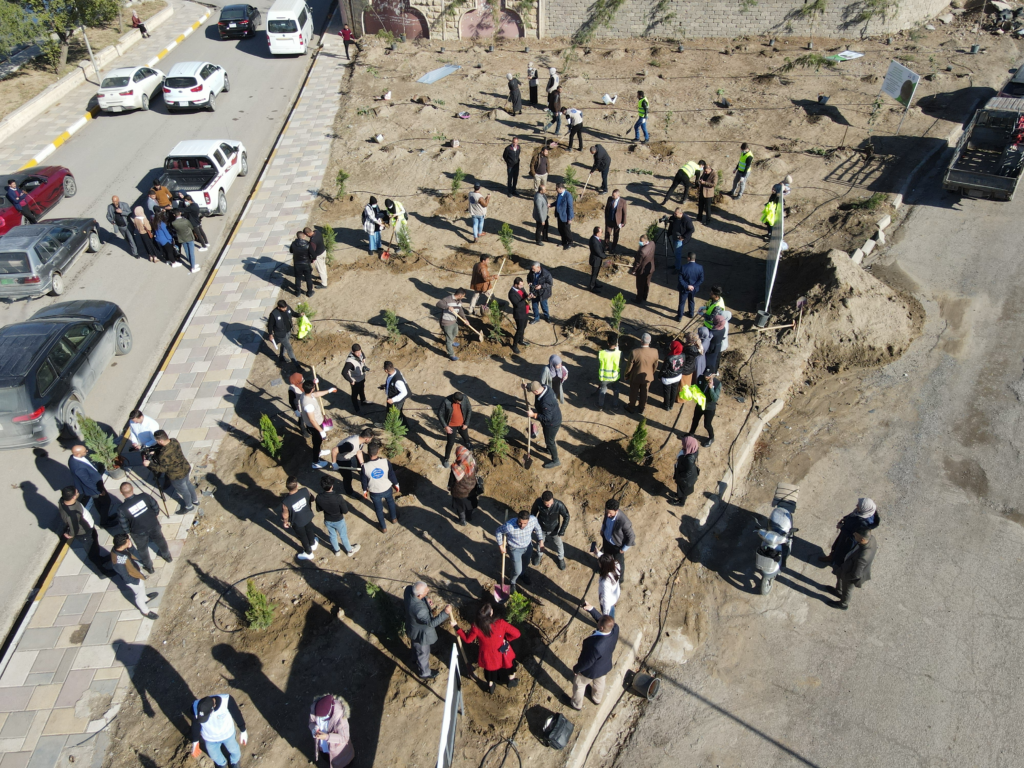
Was it easy to get the support you needed to launch Green Mosul? How was the idea first received?
At the very beginning, we sought the support of the Iraqi government, but they wanted to see results before they got involved. I then approached the French government, as I knew they were interested in such initiatives. Their cultural attaché liked the idea, so I went away and developed the initiative amongst the community. One month later, the French government approved the idea, and Green Mosul was borne. Once we’d secured the funds, the local authorities were keen to support us, and we signed agreements with the forestry department, the municipality, the universities, and with other entities in the city. It became a fully Mosuli initiative, where the people and the government were working together for a common interest: the urban greening and, at the same time, the rehabilitation of the social fabric of the city.
Was it important for you to have the local authorities involved?
It was. One of the hurdles to post-conflict recovery in Iraq is that many people see the authorities as dysfunctional. I might agree with them, but I see that there is a way of utilising this dysfunctional government by making it functional – and the only way to make it functional is when you involve them. So Mosul Eye brought the Green Mosul initiative to the government, and they helped make it happen. We didn’t have cars to transport the trees, so we used the municipality’s cars. We didn’t have the ability to create the irrigation system for the trees we were planting, so we used the forestry department. I think their involvement also helped the initiative grow. Members of the public are not necessarily aware of what ‘social cohesion’ is, but they saw Green Mosul as a reliable initiative because of how many people were involved.
Through Green Mosul, we were also aiming to create trust between the authorities and the population. We wanted it to be a collective effort, because the initiative also focused on a very important principle, which is that the process of healing has to be collective in order for it to be strong and impactful. Mosul Eye helped the government to understand the critical importance of social cohesion and of rehabilitating the social fabric, but at the same time, the government gave us the equipment and the space. I think we contributed collectively, and that’s why I always say that this is an initiative of Mosul – it’s not just an initiative of Mosul Eye. It’s important to show the people that they have agency in the process of their healing. They need to own it.
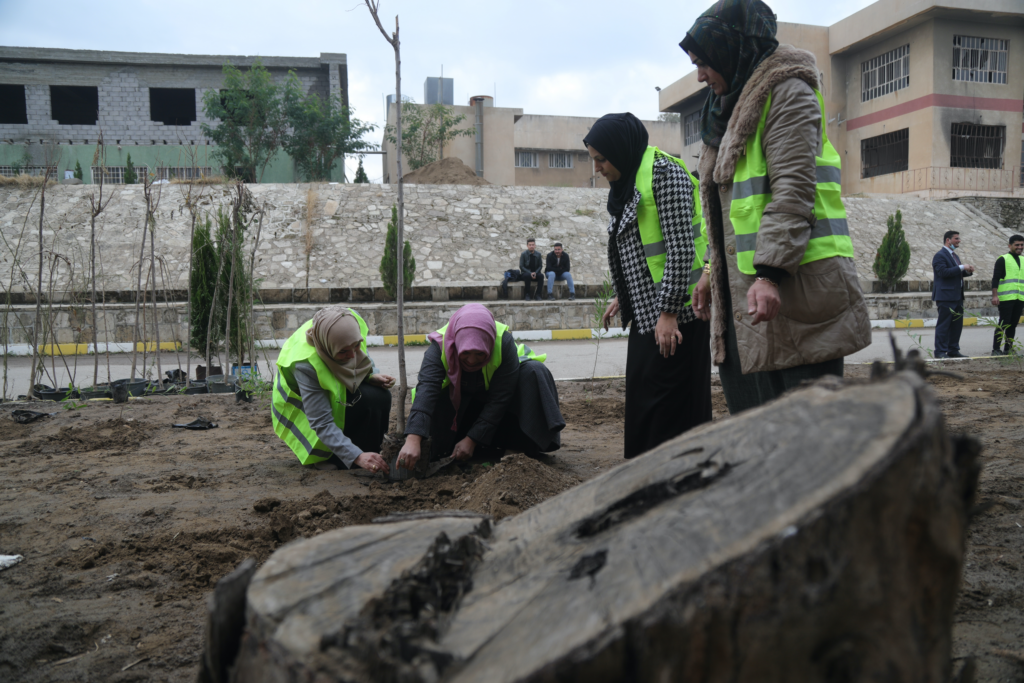
What was the response like among the local community? Were people keen to get involved?
We had a specific communication strategy when we first approached the local communities. We made sure to keep the same distance with the community leaders and the public, because we didn’t want to create the impression that Green Mosul was only for elites. So we spoke to the Yazidis, to the Christians, to the Shia, to the Sunni, and to the endowment administrations of the Yazidis, the Christians, the Shia, and the Sunni. We made sure that the first communication was with the public, and then we facilitated their own communication with their community leaders. Once the locals initiated the conversation, the community leaders came to us, and asked to get involved.
In fact, one of the places where we planted trees was as a result of communication with a woman from Tel Keppe. She told us there was an empty park in the city, and the community wanted to use it to create a space for their children, but the land was owned by the church. It wasn’t easy to convince the church at that time, and distrust between the different religious communities was still strong. We were trying to avoid being labelled religiously – we were trying to be seen only as individuals who had an interest in rehabilitating these spaces – so I spoke to the head of the church and explained that it was a great space. The church would probably receive more visitors if people came to the public park, and everyone would be happy. The priest agreed, and we created a public space where there was both a religious site and a secular site. Today, the same priest is asking me for more trees to be planted.
Within the communities, we also started receiving offers from people saying they didn’t just want trees to be planted in their space, but they wanted to contribute trees to be planted elsewhere. One person also suggested that we plant trees for those lost during the conflict, and then everyone started coming forward with names. They wanted to put the name of their son or daughter, or their mother or father, with this tree or this tree. In the first few months, it was Mosul Eye and the municipality running Green Mosul, and then it became led by the people themselves.
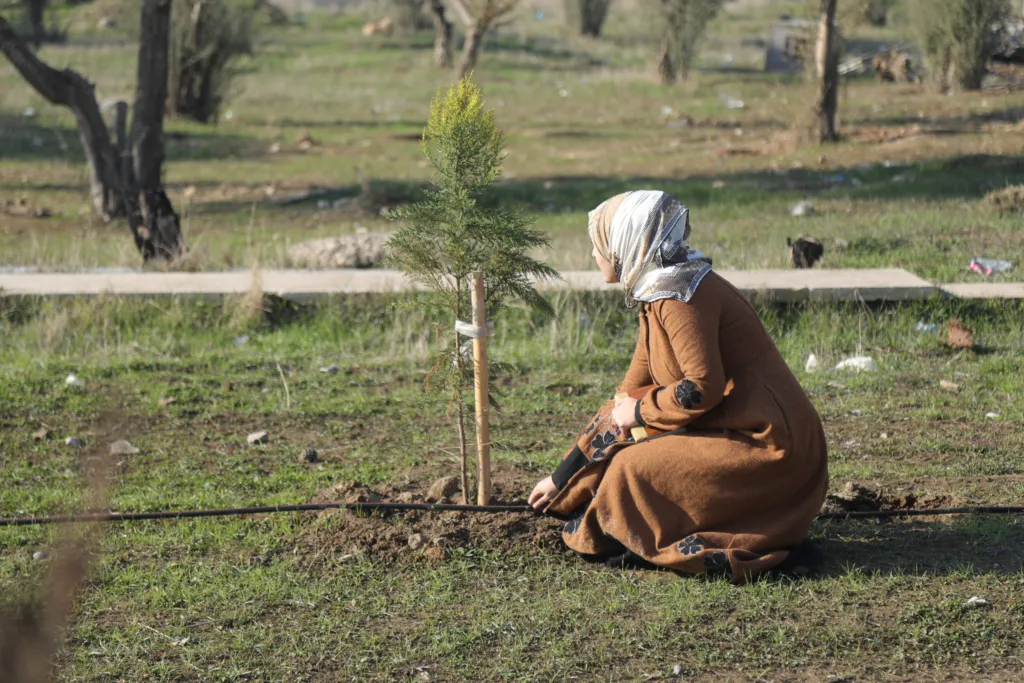
Were the sites where the trees were planted important, or was it more about the process of bringing different communities together?
The two things were intertwined. Some of the sites we chose were religious, because we wanted to try and encourage young Muslims to go to Sinjar and plant trees around the worshipping place of the Yazidis, for example, and young Yazidis to go to Bashiqa or to Mosul and plant trees inside al-Nouri mosque and Al-Saa’a church. We tried to treat these sites holistically, so we communicated to the people of those faiths that we had an interest in their religious space, but, at the same time, they were also heritage sites and public spaces for the people. We did the same in the Shia, the Sunni, the Christian, and the Yazidi majority areas, but there was one condition: that a Yazidi plants in a Muslim side and a Muslim plants in a Yazidi side and so on.
Green Mosul also planted trees in heritage sites, and we had an agreement with UNESCO, whose supervision those sites were under. We planted trees in their sites, but on the condition they would become part of the public space. We always tried to make sure that the planting of trees was seen as being outside the lens of religion – it was a holistic approach that involved everyone.
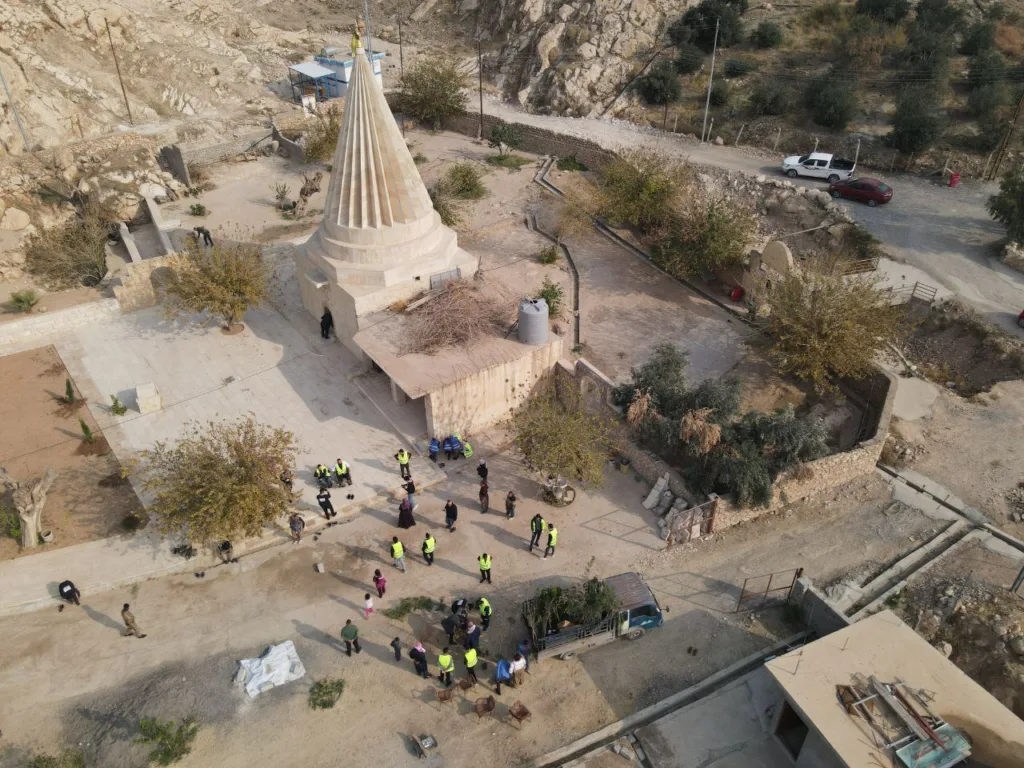
You mentioned distrust between religious communities earlier – was it difficult to persuade a person from one religion to plant trees at the religious site of another?
At the beginning, it was difficult, and sometimes we needed to have difficult conversations. But we also trained around 25 people from all communities to use as the face of the initiative. They would reach out to their communities, and they would explain that they were there wishing no harm, but they were there to contribute to the community. And when people saw the results – when they went to a place with no trees and when they went back and saw the trees planted – they understood. After a short time, things went smoothly.
When you started Green Mosul, what did you hope the outcome would be?
To be honest, when we started, I had fears it would not succeed. Given the gravity of what had happened in the city, I was concerned people might not be interested. But we started Green Mosul with three goals. One was that we would create a sense of responsibility among the people. Many had become disconnected from the city as a result of what had happened since 2003, and we wanted to reintroduce a sense of responsibility among citizens to contribute to their city. Our second aim was to introduce a mechanism of communication between communities that wasn’t about religion or ethnicity. The third was to create trust between the government and the public. I still make sure I communicate everything I do with the government, and then I communicate this to the public. I wanted to reintroduce the meaning of governance. I wanted the public to know the government is not just people sitting behind closed doors, but that they themselves can gain access to them and work with them.
We’ve achieved those three things, but we’ve also created friendships between different communities. They still visit each other, they are friends with each other, and they are still communicating. These different communities are working together, and that’s what we aimed to do, and we succeeded. I’m so happy about the results. I’m so happy about the involvement of the community. I’m so happy that we were able to do this in a complicated context, where people are still healing. This means there is potential for people to work together in Mosul to create a sustainable future for themselves, but it will take time.
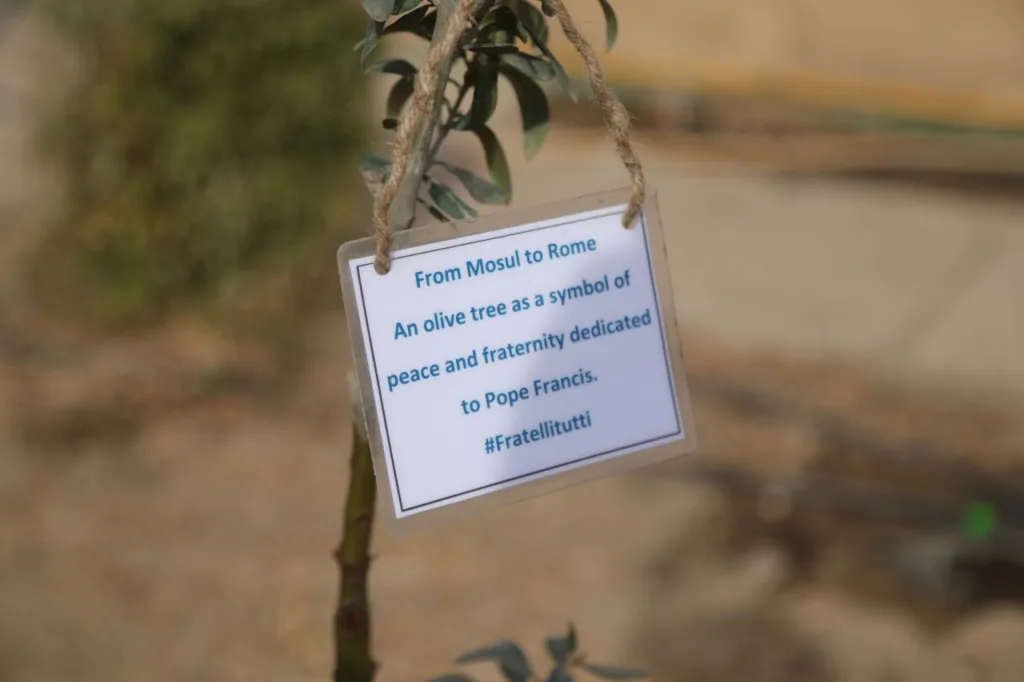
The other element we introduced is that we raised awareness about climate change in a very complicated context – imagine talking about climate change in a city that is heavily destroyed and where people are still missing. But Green Mosul succeeded in introducing the conversation around climate change, and the university is now running research and attracting more researchers to work on the subject. One topic which is dear to me is what I call ‘green heritage’. I saw the impact of the destruction of cultural heritage on the people and the potential conflicts that it might create, and I realised that, although Islamic State might not come back, there is another enemy: climate change. It’s important to address this when we speak about preserving cultural heritage. The recovery of Mosul’s cultural heritage plays an important role in the collective healing from generational trauma, and it gives hope to the people that social cohesion is still possible as well as limiting the impact of radicalisation.
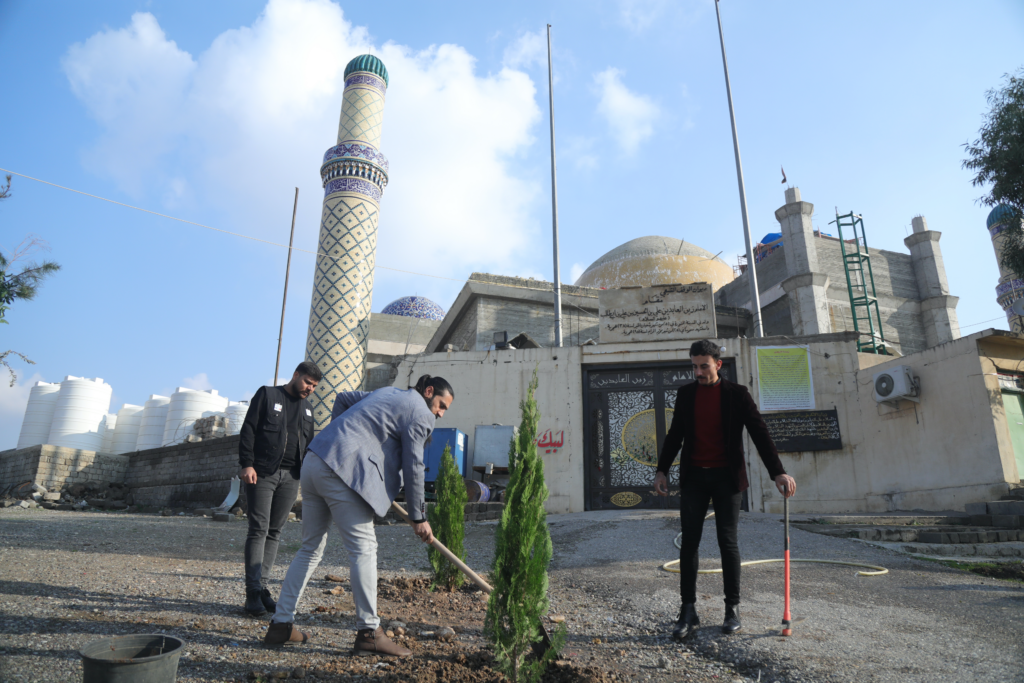
It sounds like Green Mosul has been a great success. How important do you think it is to have grassroots-led vs authority-led initiatives in Mosul?
I think encouraging the grassroots to lead more initiatives is fundamental for a healthy rehabilitation of Mosul, because not all recovery efforts succeed in meeting the results they intend. A quick rehabilitation might bring the opposite outcomes, so it’s important to create a sense of responsibility among the grassroots so they feel they have a say in what’s happening. Now is the right time to work on this, and invest in this, because we are still in the process of rebuilding and healing. It’s the best time frame we have to enable people to develop this sense of responsibility.
At the same time, we shouldn’t ignore the government. The government can always contribute, and opportunities can always be created if there’s a will, a sense of responsibility, and most importantly, diplomatic expertise – because it’s all about how you communicate your ideas in a post-conflict environment.
In Mosul, we need less focus on religion. When rehabilitation efforts target certain religious groups, they’re not talking about justice for all. They’re just reinforcing divisions. Create the space, and let people be the way they want. I think let’s talk more about trees than religion. You can plant trees in a mosque or in a church, but it doesn’t have to be because they’re a mosque or a church. It can be because you care about the environment or because you simply want to enjoy green space.
You can read more about XCEPT’s research on reconciliation initiatives in Iraq here: Iraqi heritage restoration, grassroots interventions and post-conflict recovery: reflections from Mosul
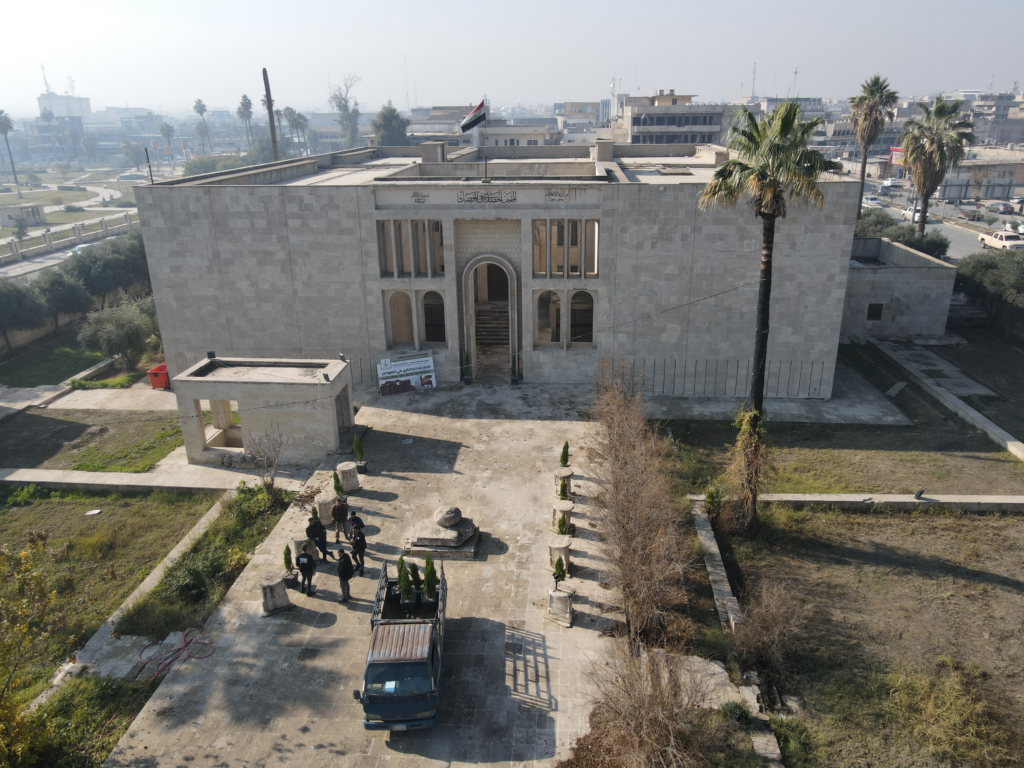
When conflicts arise around fragile or contested borders, there are knock on effects that impact local, national and regional economies, as well as relationships between state and non-state actors. XCEPT’s Local Research Network partners are studying examples of such disruptions in different regions. In Syria, Kheder Khaddour looks at the northern region, where the border with Türkiye represents a lifeline for the millions of people displaced by Syrian civil war. Azeema Cheema studies the shifting relationship between authorities in Pakistan and Afghanistan since the Taliban’s takeover, and the effect on trade and migration policies at their shared border. Lastly, Ahmed Musa explains what’s been happening in Las Anod, a major trading hub in the Horn of Africa that has been destabilised by competing actors vying for influence.
Disclaimer: The opinions, findings, and conclusions stated herein are those of the speakers and do not necessarily reflect those of the partner organizations or the UK government.
Bangladesh is facing a climate emergency. Although it is one of the world’s least polluting nations, it is already experiencing some of the most severe effects of changing weather patterns. The country lies close to sea level, and much of the land is river delta that is prone to seasonal flooding, erosion, and salinity intrusion and faces the risk of devastating cyclones, all of which can be catastrophic for local communities and their livelihoods. Many families are unable to recover from such climate disasters and are forced to move to other parts of Bangladesh or across borders to rebuild their lives.
Unsurprisingly, Bangladesh has become a prominent voice in global conversations about climate change and the need for international responsibility-sharing. Developing nations generally shoulder an outsized share of the costs of climate change compared to wealthier nations, a fact recently recognised in global forums such as the United Nations Climate Change Conference, which convenes the annual Conference of Parties, or COP. In its 27th sitting, in 2022, the COP established a loss and damage fund for vulnerable countries, which was operationalized a year later at COP 28. While proponents celebrated this as a win, many practical challenges remain, including raising sufficient funds and figuring out how to measure losses and distribute resources equitably among nations. The many intersecting consequences of environmental degradation require long-term solutions and a holistic approach. Mechanisms like the loss and damage fund will not increase climate resilience if social, political, and economic factors are not considered alongside the environmental ones. Migration and displacement of affected populations is one of the most significant consequences of climate change. Along with the downstream impacts on labor markets, social networks, and transnational relationships, these will need to be accounted for in national and international climate strategies and development policies.
As “ground zero” for a shifting climate that is turning many environments inhospitable, Bangladesh offers a case study of these overlapping vulnerabilities. In parts of the borderlands with India, longstanding social and political fragilities lie beneath the new environmental stressors. The border itself has been an historical point of contention between the two countries, and security measures in the past have led to violence. The distance from central governance institutions in Dhaka can result in border regions being underrepresented in national climate strategies, including the distribution of resources, which can further marginalize ethnic and religious minorities within border communities. The risks from climate change in such areas of existing vulnerability cannot be overstated: economic instability, food insecurity, unreliable access to justice, and increased inequalities that can trigger communal violence.
Attempts to institutionalise sustainable solutions in climate-vulnerable areas must be rooted in a situated understanding of how communities experience and respond to environmental disruptions. Outsiders may struggle to grasp these nuances, which can lead to poor planning and interventions that cause further harm. In southwestern Bangladesh, for example, seasonal and informal migration to urban centers in India have become more and more of a survival mechanism for those who have lost their agricultural livelihoods. This can clash with policies that regulate cross-border movement, including the steady increase in border fencing. Researchers and practitioners working in affected areas can play an important role in collecting information and building evidence that speaks to local experiences, but this must be done with sensitivity and recognition of the power dynamics of classical research settings. Historically, the study of vulnerable populations in particular has been steeped in inequality and defined by an essentially extractive relationship between researchers and researched.
As the world mobilises to support climate adaptation and resilience, decision-makers need analysis that reflects the needs and priorities of communities at the forefront of climate change. The Asia Foundation is working with the Centre for Peace & Justice (CPJ) of BRAC University in Bangladesh to develop a framework for assessing how existing drivers of fragility interact with the onset of climate change, in order to understand the risks for future climate resilience and development programming in the country. The Foundation’s partnership with CPJ originates in the UK-funded development research program XCEPT, Cross-Border Conflict: Evidence, Policy, and Trends, which works with local researchers to provide analysis of conflicts in border regions that is grounded in the affected communities.
With support from this program, CPJ has developed a new methodology for community-driven data collection, based on “participatory research,” that seeks to avoid the vertical power dynamics inherent in traditional research models. CPJ first employed this methodology among the Rohingya refugees seeking asylum in the Bangladeshi coastal town of Cox’s Bazar, on the border with Myanmar. A network of researchers drawn from within the refugee community itself enabled the affected population to become co-producers of knowledge and solutions, building trust between aid providers and recipients and strengthening the credibility of the research findings. The insights this yielded have helped foreign donors and humanitarian agencies operating in the world’s biggest refugee camp to work more effectively. This approach is a major contribution to localising aid, as it shifts power over information towards the affected populations.
This year, CPJ is piloting the same research approach in southwestern Bangladesh, applying it to the question of how climate adaptation strategies reflect and respond to broader social and political fragilities in the local context. A scoping study first undertaken by the team in 2022 determined that this question is a major factor in the long-term success of such strategies. Subsequently, a research project was designed replicating the approach used in Cox’s Bazar, starting with the recruitment and training of young people to work as “community researchers.”
The team faced some initial challenges: refugee camps are an entirely different operational context than areas of the general population, because of the institutional control within the camps and the relative immobility of the camp population. Furthermore, the severity of the refugee crisis in Cox’s Bazar was a powerful motivator for camp residents to participate. In southwestern Bangladesh, on the other hand, researchers wondered how to build interest among local youth in participating in the data collection and how to encourage respondents to open up about their experiences and aspirations. Researchers have also reflected that the obstacles facing Rohingya refugees in their fenced camps are immediate and tangible, while slow-onset climate factors that distress and uproot communities in climate-affected border towns are less immediately apparent.
To apply a proven methodology in a completely new context, both major and seemingly minor aspects of the research study may need to be revised. CPJ’s community-based research approach acknowledges the complexity and unique social order of the borderlands, allowing for a more comprehensive understanding of the study sites. Climate realities around the world are not equal. These locally grounded methods of exploration avoid the mistakes of knowledge systems that force top-down assumptions on local communities, and instead empower them to be the voices of their own experience.
The initial phase of this new project is nearing completion, and community researchers are receiving training for the first round of data collection. From where we stand now, there is much to discover, to learn, and to unlearn, and we hope to do it together.
Tabea Campbell Pauli is a senior program officer with The Asia Foundation’s XCEPT program, and Tasnia Khandaker Prova is a research associate with the Centre for Peace and Justice of BRAC University. They can be reached at [email protected] and [email protected], respectively. The views and opinions expressed here are those of the authors, not those of The Asia Foundation.
Syria’s south is caught precariously between two realities. On one side, there is Israel’s resolute campaign to neutralize border threats, particularly after the traumatic Hamas attack of October 7 last year. On the other, there is Iran’s growing entrenchment in Syria’s southern border regions, especially Quneitra Governorate, which is aimed at securing geopolitical leverage in the region. Unless there is a significant change in the current status quo, there could be a military escalation down the road that again undermines regional stability.
Looking at southern Syria after Syrian government forces returned to the region in 2018, one can’t help but notice an irony. The deployment of the army and security forces was largely premised on an understanding among Russia, the United States, Israel, Jordan, and the Assad regime in Damascus allowing for their return, but on the condition that Iran and its allies would not return with them. Moscow was to guarantee the arrangement. However, today what we are seeing, instead, is a contest for domination of the south in which Iran has accumulated power while Russia and the Assad regime have lost ground.
The war in Ukraine, which has compelled Moscow to reallocate its resources and refocus its energies, has been the main cause for the relative decline of Russian sway. Russia had a multifaceted presence in Syria. It played the role of active combatant, with personnel on the ground; it had an influential diplomatic role in negotiations to resolve the Syrian conflict; and it played a unique intermediary role, brokering agreements among stakeholders who otherwise had no direct communication with each other, which enhanced its leverage.
The agreement to return government forces to the south in 2018 was a byproduct of this unique position. Yet since then, Israel and Iran have exploited the erosion of Moscow’s influence. At the same time, there has also been a continious decline in the strength of the Assad regime. This has resulted from a combination of factors, including U.S. sanctions, Syria’s continued isolation at the regional level, and the systematic breakdown of the Syrian state as a consequence of the uprising.
The outcome of this disastrous situation has been visible both economically and politically. For example, the Syrian pound was valued at SP3,600 to the U.S. dollar on the day Russia began its offensive in Ukraine, and now it hovers just below SP14,000—a depreciation of approximately 290 percent. Another sign comes from Suwayda, where the Druze community—historically not aligned with the opposition—has been staging continuous protests against the regime since August 2023 for failing to provide security, stability, and basic services, among other things. The authorities have not been able to quell these protests. Meanwhile Arab countries, chiefly Jordan, are also concerned about developments in the south, but have little ability to influence the course of events there.
Though Iranian influence may be rising, Tehran does not exercise control over the south, while facing numerous obstacles there. Israeli opposition is the most significant. Israel has continiously targeted Islamic Revolutionary Guard Corps and Hezbollah officials since 2013, with more than 240 strikes across Syria. Iran has also faced local pushback. In Daraa and Suwayda Governorates, the population is largely hostile to the Iranians, who have progressed in a limited way in these areas. Data collected by the author on Israeli airstrikes between 2013 and February 2024 show that Daraa and Suwayda were targeted far less frequently—only seven times—than the hundred or so times Rural Damascus Governorate was targeted. This indicates that Israel doesn’t consider Daraa and Suwayda to be substantial threats.
But Iran has had some successes as well, namely in the highlands of Quneitra that remain under Syrian control and overlook the Israeli-occupied Golan Heights. Iran and its allies have been able to consolidate their position in this region. Geographically, its rugged, mountainous terrain allows for concealment, facilitating militia operations and movement. Quneitra’s proximity to the Lebanese border, which is under Hezbollah control, and southern Rural Damascus Governorate, where Iranian influence is pronounced, has further confirmed the broader region as a nexus of Iranian-aligned activity.
In addition to this, local dynamics in Quneitra during the Syrian uprising created openings for Iran and its allies. Between 2015 and 2018, the Sunni extremist group Jabhat al-Nusra controlled the area and threatened the small Druze and Christian populations. In response, these communities forged ties with Iran and, especially, Hezbollah for protection, allowing the Iranians to retain a foothold on the Quneitra front throughout Syria’s conflict. That is likely why, since 2013, Quneitra has been the second most frequent target of Israeli strikes, being hit 30 times.
What gives a strategic edge to Iran in the south is the disorder that followed the return of government forces in 2018. The security situation has remained precarious and there is a growing illicit economy, both of which have created an environment conducive to the expansion of Iranian influence. Iran’s experience in operating in such settings in the Middle East is unparalleled. In principle, the Assad regime and its institutions should have had the advantage, given their local knowledge. However, they are resourceless, have lost the mechanisms of control they had before 2011, and are now greatly dependent on Iran.
Interestingly, after the start of the Gaza war last year, Russia stepped up its presence along the Golan Heights by establishing several observation posts. This presence could increase pressure on Iran or help mitigate an Iranian-Israeli confrontation in southern Syria, even if Moscow cannot replace or undo Iranian influence. Russia is not only dependent on Iran because of the Russian war in Ukraine, it has also failed to create a strong network of local proxies tied with patronage networks like Iran has done. Therefore, if Iran continues to reinforce itself near the occupied Golan, or deploys more weaponry there, a conflict with Israel may become inevitable.
This article was originally published on Diwan, hosted by the Malcolm H. Kerr Carnegie Middle East Center.
Since 2011, the conflict in Syria has transformed the country’s border areas. In most of these, Syrian sovereignty is now contested to varying degrees among local, national, and regional actors. These dynamics have led to a situation in which a variety of political centers (other than Damascus) have come to exercise influence over borders. Though there are stark differences among these border regions, they all have in common the fact that they are entities outside Damascus’ control, each with its own economy, security, and even ideology—effectively, de facto cantons.
Controlling Syria’s borders has always been a central aspect of the Assad regime’s power. However, given its loss of influence over many of its borders—added to its merely tentative authority over those border areas controlled by allies—what we are seeing today in the country is a significant long-term transformation in the way Damascus operates. It is unlikely that the regime will restore state sovereignty over these border areas anytime soon. Rather, in the coming years developments there are likely to be determined by local and regional actors, and the interactions between them.
Multiple variables will affect the outcome of these interactions. These can be placed into three broad categories: demographics, or more specifically the fate of the displaced and refugees; markets, or what might be called cross-border economic relations; and security. Given the likelihood that Damascus will be unable to restore full control over its border regions, the question is whether efforts to resolve the Syrian conflict should not encompass a wider range of local and regional actors, while also focusing on demographics, markets, and security? Such questions are what a group of Carnegie scholars hope to address in a forthcoming paper.
The movement of people has played a major role in border regions, notably the north. But these trends have also been characterized by a paradox. The regime has pursued a policy of reducing hostile populations under its control by allowing for the creation of large areas where it has a limited presence, or none at all—such as Idlib Governorate near the Turkish border. But this has also undermined the state’s sovereignty over these territories. Northeastern Syria, where the regime has allowed an entire segment of its population, namely the Kurds, to create a self-governing entity is equally representative of such an approach.
As cross-border markets and economic ties have developed, they have transformed, and in some cases even replaced, prewar market relationships in particular areas. Control over such relationships had also constituted a major factor in the Syrian state’s power before the conflict. New economic ties, as seen in the town of Sarmada, for instance, have tied border regions more closely to Türkiye than to Damascus. This development represents another aspect of the deterioration in Syrian state sovereignty over these areas.
Security, however, remains the main issue that will shape the future of Syria’s conflict in the country’s border regions. Over the last decade or so, Syria has seen the emergence of a number of parallel security orders—Turkish, Iranian, and American—each within specific geographical zones of operation and influence. While these may differ from each other, they too have all greatly eroded the sovereignty of the Syrian state and regime.
The Turkish security order has established effective self-defense zones and reshaped local power structures in parts of the north where the Turkish military has a presence. The more fluid Iranian model has connected Iraq to eastern and southern Syria and Lebanon through the promotion of local, pro-Tehran militias. The example of the crossing with Iraq has shown how Iran uses such passageways for its militias, allowing it to exert regional influence, even as it expands its sway over armed Arab tribal groups in the area. The United States also has a presence in eastern and northeastern Syria, as well as in the Tanf base near Jordan, which began as part of American participation in the coalition to fight the Islamic State group. For the foreseeable future, Damascus’ ability to restore its sovereignty in all these border locations will be virtually nonexistent.
The conflict in Syria has completely destroyed the country’s national framework, with local-regional having risen on its ruins. These ties have expressed themselves across all of Syria’s borders. The established approaches to resolving the crisis are therefore no longer useful today. The Geneva process, which assumed a political transition would take place within a Syrian national framework, is unrealistic. Not even the local deals that emanated from the security-focused Astana process between Iran, Russia, and Türkiye are effective. Neither takes into account the radical transformations that have shaped Syria’s political, social, and security structures since the war began. Until a new approach is tried, one that includes an effective local element within new regional equations, Syria will remain in limbo, at the expense of both its sovereignty and a society devastated by war.
This article was originally published on Diwan, hosted by the Malcolm H. Kerr Carnegie Middle East Center.
XCEPT researchers Renad Mansour and Zmkan Ali of Chatham House join the On Geopolitics crew to discuss their new XCEPT report on cross-border conflict. Why is Sinjar, stuck between Iraq and Syria, enmired in other ongoing conflicts? And can anything be done to improve the situation in Sinjar while those conflicts are unresolved?
Renad and Zmkan argue that according to their latest XCEPT research, unless the non-state armed groups active in Sinjar are involved in negotiations about the future of Sinjar, there can be no lasting resolution.
XCEPT Chatham House researchers Tim Eaton and Leah de Haan (Chatham House Middle East and North Africa Programme) discuss their XCEPT research on the transnational links between the movement of people and armed conflict – from Edo State in Nigeria, through Niger, to Libya.
As the devastating war in Sudan nears the one-year mark, it remains fuelled by transnational military business networks. One such sector funding the military activities in Sudan’s gold sector.
In this episode, XCEPT researcher Ahmed Soliman discusses his upcoming research on the Sudan conflict and its link to the gold sector – from how gold has evolved as a ‘conflict good,’ its connection to the current war and transnational dynamics.
Dr Suliman Baldo (Executive Director, Sudan Transparency and Policy Tracker) gives an overview of key political shifts in Sudan’s history that have facilitated links with the country’s gold sector.
Denise Sprimont-Vasquez joins the podcast to discuss the economic activities and illicit networks that are fuelling the war.
On 8 March, the UN Security Council adopted a UK-drafted resolution calling for an immediate cessation of hostilities in Sudan during the month of Ramadan, a sustainable resolution to the conflict through dialogue, compliance with international humanitarian law and unhindered humanitarian access.
Eleven months into the war, this is the first time that the Council has been able to agree on a resolution. The mandate of the UN Panel of Experts that monitors the sanctions regime in Darfur was also renewed by the Council. Does this signify hope that efforts to end the war might gather momentum? Or is Sudan likely to face a protracted conflict?
The war between the Sudan Armed Forces (SAF) led by General Abdel Fatah Al Burhan and the paramilitary Rapid Support Forces (RSF) led by General Mohamed Hamdan Dagalo (known as ‘Hemedti’) is a competition for power and resources between rival factions of the regular armed forces.
But it is also rooted in Sudan’s long history of internal conflict, marginalization of the peripheries and lack of accountability for atrocity crimes. Both the SAF’s officer corps and the RSF are creations of former President Omer al-Bashir’s regime.
Each has shown disregard for the lives of Sudanese civilians by waging war in densely populated urban areas. The scale of destruction is unprecedented in Sudan’s modern history.
The conflict has the potential to destabilize already fragile neighbouring countries, create large new migration flows to Europe, and attract extremist groups.
With the world’s attention focused on Gaza and Ukraine, the war receives woefully little high-level political, parliamentary or international media attention, raising serious questions about double standards in dealing with global crises, particularly conflicts in Africa. Sudan is suffering from a humanitarian disaster, with a looming famine and the world’s biggest displacement crisis: 8 million people are newly displaced inside or outside the country, in addition to over 3 million displaced by previous conflicts.
The head of the World Food Programme has warned that the war risks creating the world’s largest hunger crisis. Yet the UN’s Humanitarian Response Plan for Sudan is only 4 per cent funded.
The conflict has the potential to destabilize already fragile neighbouring countries, create large new migration flows to Europe, and attract extremist groups.
Meanwhile, regional actors are fighting a proxy war in the country, giving military, financial and political support to the warring parties. The involvement of Russia and Iran has given the war a geopolitical dimension linked to Putin’s war in Ukraine – partly funded with Sudanese gold – and competition for influence on the Red Sea coast.
Both RSF and SAF forces have used hunger as a weapon of war. The RSF has looted humanitarian warehouses and besieged cities. The SAF-controlled Humanitarian Aid Commission has systematically withheld authorization for crossline movement of life-saving aid to RSF-controlled areas.
Donors will also have to step up to address the spiralling food crisis, by reducing the UN funding gap and supporting grassroots first responders in the Emergency Response Rooms.
One limited outcome from recent international pressure has been the partial reversal of the SAF’s ban on cross-border humanitarian access from Chad into Darfur. The de facto SAF authorities in Port Sudan have agreed to open limited border crossings from Chad and South Sudan. However, MSF International have criticized this as a partial solution at best.
The UN will need to monitor implementation to ensure neutrality in the distribution of aid, while intensifying pressure for unhindered cross-border and crossline humanitarian access.
Donors will also have to step up to address the spiralling food crisis, by reducing the UN funding gap and supporting grassroots first responders in the Emergency Response Rooms.
There is growing pressure for a cessation of hostilities: the fact that the UN Secretary-General, the UN Security Council, the African Union, and the League of Arab States joined forces to call for a Ramadan truce, represents a significant increase in pressure on the warring parties.
Nevertheless, Ramadan has started with further fierce fighting. It is unclear how the Security Council expected a truce to take effect without prior diplomatic engagement to agree an implementation and monitoring mechanism.
Command and control is fragmented on both sides and the warring parties have failed to abide by previous temporary truces negotiated through the Saudi/US-sponsored Jeddah Platform. Concerted diplomacy at the highest level is therefore urgently needed. The aim must be to change the calculations of the generals and counter the influence of hard-line Islamists from the Bashir-era who are blocking negotiations: whether this aim is achievable within the current context remains to be seen.